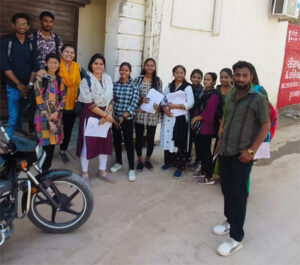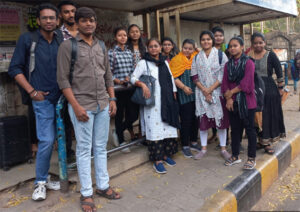- Lack of education, especially higher education is a key concern in Randesana Village: Survey
- Only 20% people of the Randesana village are graduates
- On the other hand 60% of the families in the village have only studied up to class 8 or 10
NE EDUCATION BUREAU
AHMEDABAD, MARCH 29
Despite the efforts of the State and Central governments ‘Beti bachao, beti padhao’ campaign and various incentives, 40% of the girls in the Randesana village are denied permission to pursue education beyond the boundaries of their village, says a survey.

Students of Smt SR Mehta Arts College which is part of the Navgujarat Group of Colleges, recently conducted and concluded a Sociological Survey of the Randesana village of Gandhinagar district. Third Year students of the Sociology department of the institution conduct a village survey every year and release the findings as part of their academic curriculum.

Smt SR Mehta Arts College, a five decades-old college, is part of the Navgujarat Group of Colleges and dedicated to excellence in education in various subjects of art.
Some 30 students of the Sociology Department were involved in conducting the survey under the guidance of two professors, Dr Seema Badgujar, the head of Sociology Department at Smt. S. R. Mehta Arts College and Professor Masri Vadhel.
Randesana is a developed village situated and has a population of 1,782 people. The survey was conducted through written forms involving both qualitative and quantitative questions. The findings provide a detailed understanding about the level of education of people in the village, their casts, occupation, challenges and concerns and about the village infrastructure.
The survey revealed a stark finding that only 20% people of the Randesana village were graduates. On the other hand 60% of the families in the village have only studied up to class 8 or 10. The remaining 20% of the villagers are illiterate.
Randesana village comprises people from castes, including Rathod, Darbar, Gohil, Thakor, Vaghela, Rajput, Makwana & Parmar, among others, all of whom are primarily engaged in cattle-rearing, agriculture and labour.
While the reasons for lack of education were not clear, the survey revealed that the village community has begun prioritizing girl child education, and now families are more openly granting permissions to their daughters for further studies.
“40% of the girls in the village are denied permission to pursue education beyond the boundaries of their village,” the survey stated, which indicated one of the challenges for lack of education, especially higher education among girls.
Societal beliefs and superstitions could also be potential reasons for lack of education, especially among women.
“The dowry system persists widely in the village, with a preference for intra-caste marriages. Marriageable age is typically considered to be between 18 to 21 years. Approximately 20% of the population believe that providing dowry ensures the happiness of the bride,” according to the survey.
Infrastructure-wise however, the village has seen much improvement. “With its proximity to Gandhinagar, the village has seen several development projects like the construction of a riverfront. In fact, the establishment of a primary school and a health-centre in the village also led to an increase in awareness about health among residents,” the survey states.
The village also has good access to clean drinking water through taps installed in households, with very few individuals resorting to water from wells or rivers, according to the survey.
A majority of the families of the village are joint families, many a time with at least 10 people residing in the same households.












